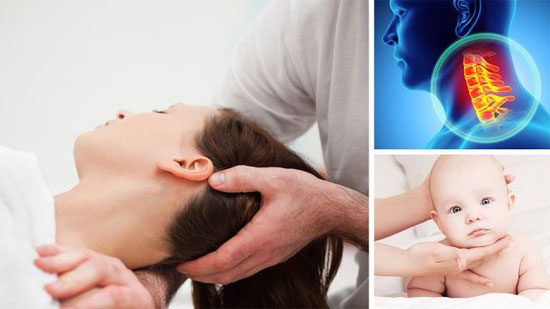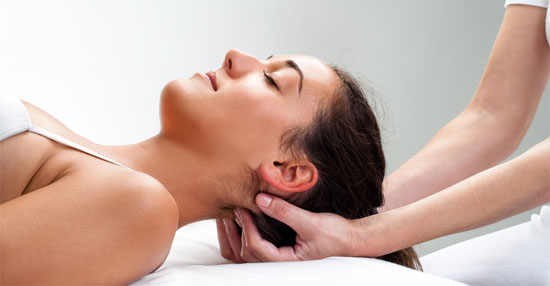Cure Your Headaches plus Seven Other Benefits of Craniosacral Therapy
By Liivi Hess

Three weeks after our daughter was born, she started having issues. Crying constantly, straightening her legs as if she was in pain and flat-out refusing to sleep. In our desperation, we talked to friends who were about five months ahead of us in the parenting game — they instantly recommended craniosacral therapy.
I’d never heard of the technique and was a little hesitant to thrust my newborn child at the nearest craniosacral therapist without first doing my research. Based on the name, I was fairly certain it had something to do with manipulating the bones of the skull, which isn’t something you want to get wrong.
After doing some serious research on the internet, it turned out that craniosacral therapy is a popular treatment prescribed for anyone from the age of two weeks to 80 years of age. Typically practiced by osteopathic or chiropractic practitioners, craniosacral therapy uses only gentle touch to manipulate the bones of the skull, spine and sometimes pelvis.
Developed by osteopathic physician John E. Upledger in the 1970s, craniosacral therapy is believed to regulate the flow of cerebrospinal fluid. That probably doesn’t mean a lot to the average person, but this fluid surrounds the brain and spinal cord, acting as a cushion that protects the brain from both mechanical and microbiological damage. Thus with normalization of the cerebrospinal fluid, both the brain and neck are supported and recovery is promoted. In this way, craniosacral therapy provides a safe treatment for people of all ages.
So what are the benefits of craniosacral therapy? Plenty, as it turns out! Here are just a few ailments it cause treat:
1. Neck pain
Much of the tension in our neck is often due to tight muscles around the base of the skull and the way in which we hold our head… which just so happens to be pretty darn heavy! Craniosacral therapy gently manipulates the muscles and bones around this area, helping to alleviate tension and possibly providing an effective way to alleviate neck pain.
2. Headaches
Having suffered from multiple concussions in my youth, I know all about headaches. The neurologists I’ve talked to over the years regarding my head injuries all concur on the same thing: these headaches are likely caused by bruising on the outside of my brain, caused by me (foolishly) hitting my head so hard that my brain literally sloshed into the side of my skull.
The fluid that is designed to prevent such bruising from occurring is none other than the cerebrospinal fluid I discussed earlier, therefore it stands to reason that by promoting healthy flow and homeostasis of that cerebrospinal fluid, one might gain relief from chronic headaches. I haven’t yet tried it myself, but it might be worth giving craniosacral therapy a go if you’re dealing with frequent or debilitating migraine headaches.

3. Central nervous system disorders
The central nervous system is a complex system of nerves that controls virtually every aspect of the body. Comprised of the brain and the spinal cord, it makes sense that the central nervous system would respond favorably to the gentle massaging motions applied to the brain and upper spine during craniosacral therapy. For this reason, many people suffering from central nervous system disorders have reported significant recovery following repeated craniosacral therapy applications.
4. Immune dysfunction
The cerebrospinal fluid that surrounds the brain and spinal cord is designed to not only protect these critical organs from physical damage, but also to prevent infection from bacterial invasion. By helping to regulate the flow of this fluid, craniosacral therapy may help to dramatically increase your immune system function.
5. Chronic fatigue
Chronic fatigue affects millions of people, significantly reducing their ability to deal with stress of any kind and placing them in a state of constant tiredness and overwhelm. Craniosacral therapy is thought to reduce excess adrenalin in the body, one of the key contributors to chronic fatigue.
6. Fibromyalgia
As a condition associated with abnormal central nervous system function, symptoms of fibromyalgia may respond well to repeated applications of craniosacral therapy. The gentle palpitations applied during craniosacral therapy can help to alleviate the constant pain many fibromyalgia patients suffer from, along with supporting healthy brain function and lowering chronic stress levels.
7. Fertility issues
Many people who struggle to conceive are often inhibited by chronic stress. In a constant state of stress, the release of adrenalin and cortisol dampens the other “normal” processes in the body, favoring only those required to survive. In this chronic stress state, the body sees no reason to reproduce; its main goal is to get itself to a place of safety.
With this in mind, often the key to improved fertility is simply to alleviate stress. Craniosacral therapy promotes stress relief in multiple ways, including via the act of gentle massage and by supporting healthy brain and spine function. A 2012 study published in the Journal of the American Osteopathic Association found that 60 percent of women treated with manual therapy (a category that includes craniosacral therapy) were able to transition from a state of infertility to conceive within three months and deliver to full term.
8. Sinus problems
Sinus problems can hit at any time, and quickly make your life miserable. Whether those problems are due to seasonal allergies or anatomical issues, they may respond positively to craniosacral therapy. Craniosacral practitioners can apply gentle pressure to the tissues under the facial and nasal bones, which in turn can relax the surrounding tissues and improve circulation. The result is a reduced propensity for allergic reactions and less stuffiness and pain.
yogaesoteric
March 4, 2019
Also available in:
 Français
Français
